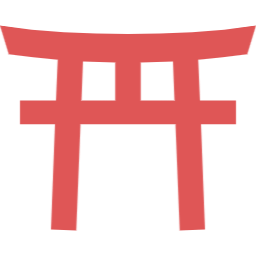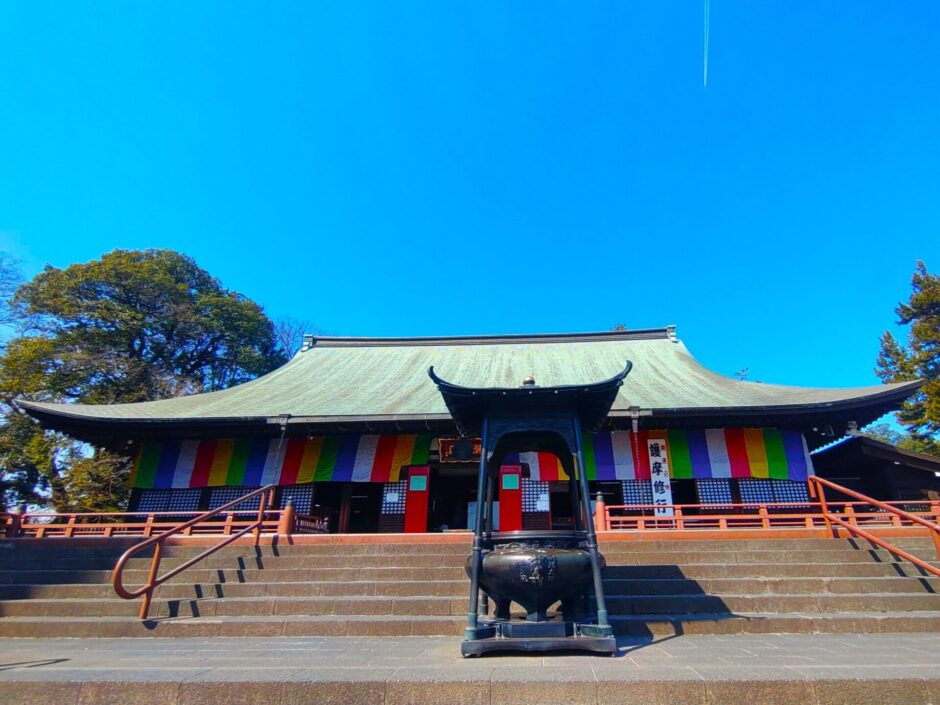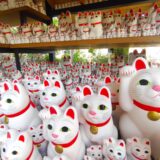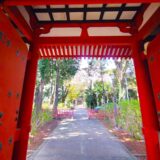目次
- 【Kita-in Temple summary】
- 【Kita-in Temple Sanmon(main temple gate)】
- 【Kita-in Temple bell tower gate】
- 【Kita-in Temple two-storied pagoda (with a square base, pent roof and a round top)】
- 【Kita-in Temple Kyakuden, Shoin, Kori (storehouse)】
- 【Kita-in Temple Jikeido】
- 【Kita-in Temple Jigendo】
- 【Kita-in Temple statues of arhats(Gohyakurakan zo)500 Rakan】
- 【Kita-in Temple Nearby attractions】
- 【Kita-in Temple Access】
- Manager’s Comments
- Kita-in Temple
【Kita-in Temple summary】
Kita-in Temple was founded in 830. It is said to have been founded by Ennin at the order of Emperor Junna (the 53rd Emperor) as Muryōju-ji Temple to spread the teachings of the Tendai sect in the East. The present Kita-in Temple is based on the Kyakuden, Shoin, and Kori (storeroom), which were relocated from buildings in Edo Castle under the direction of the third shogun, Tokugawa Iemitsu, when they were destroyed in the Great Kawagoe Fire of 1638. Therefore, the buildings that once stood at Edo Castle are the most extant in Kawagoe.
【Kita-in Temple Sanmon(main temple gate)】
![Kita-in Temple [Saitama] DSC 2442 1 1024x768 - Kita-in Temple [Saitama]](https://japan-shrine.info/wp-content/uploads/DSC_2442-1-1024x768.jpg)
Sanmon is the oldest existing building in Kita-in Temple and was built in 1632. It was built in 1632 and is now designated as a National Important Cultural Property.
【Kita-in Temple bell tower gate】
![Kita-in Temple [Saitama] DSC 2440 1024x768 - Kita-in Temple [Saitama]](https://japan-shrine.info/wp-content/uploads/DSC_2440-1024x768.jpg)
It was built in 1702 (Genroku 15). It is now designated as a National Important Cultural Property.
【Kita-in Temple two-storied pagoda (with a square base, pent roof and a round top)】
![Kita-in Temple [Saitama] DSC 2370 1024x768 - Kita-in Temple [Saitama]](https://japan-shrine.info/wp-content/uploads/DSC_2370-1024x768.jpg)
The Taho-to (pagoda) is designated as a tangible cultural property of the prefecture.
![Kita-in Temple [Saitama] DSC 2381 2 1024x768 - Kita-in Temple [Saitama]](https://japan-shrine.info/wp-content/uploads/DSC_2381-2-1024x768.jpg)
In spring, there are stalls around the plaza as the site of the Cherry Blossom Festival, and the cherry blossoms are beautiful.
【Kita-in Temple Kyakuden, Shoin, Kori (storehouse)】
![Kita-in Temple [Saitama] DSC 2388 1024x768 - Kita-in Temple [Saitama]](https://japan-shrine.info/wp-content/uploads/DSC_2388-1024x768.jpg)
Purchase a ticket to enter Kyakuden. The Kyakuden, Jiedo, and Five Hundred Arhats are included in the set price of 400 yen. The Kyakuden includes the room where Tokugawa Iemitsu was born. It was moved after the Great Kawagoe Fire, and together with Shoin and Koriuchi, it is a separate building of the Edo Castle’s Momijiyama (Imperial Palace). Please note that photography is prohibited inside the facility.
![Kita-in Temple [Saitama] DSC 2401 1024x768 - Kita-in Temple [Saitama]](https://japan-shrine.info/wp-content/uploads/DSC_2401-1024x768.jpg)
However, the garden seen from this side of the building is wonderful, and the weeping cherry tree, which was hand-planted by the third shogun, is in full bloom. (Photography of the garden is allowed.)
![Kita-in Temple [Saitama] DSC 2411 1024x768 - Kita-in Temple [Saitama]](https://japan-shrine.info/wp-content/uploads/DSC_2411-1024x768.jpg)
There is also a karesansui-style kyokusui (dry landscape garden) at the rear of the Kyakuden. There is a bridge from the Kyakuden to the hall, which leads to Jiedo.
【Kita-in Temple Jikeido】
It was built in 1639. It has been renovated several times and is designated as a tangible cultural property of the prefecture.
![Kita-in Temple [Saitama] DSC 2376 2 1024x768 - Kita-in Temple [Saitama]](https://japan-shrine.info/wp-content/uploads/DSC_2376-2-1024x768.jpg)
It is a very meaningful experience to see the principal image up close, with Jie Daishi enshrined in the center and Fudo Myoo enshrined on either side. It is such a pity that I could not take pictures of it.
【Kita-in Temple Jigendo】
It is located on a small hill a short distance from Jikeido (using an early 7th century burial mound).
![Kita-in Temple [Saitama] DSC 2417 1024x768 - Kita-in Temple [Saitama]](https://japan-shrine.info/wp-content/uploads/DSC_2417-1024x768.jpg)
Monk Tenkai apparently served as a brain to three generations of Ieyasu, Hidetada, and Iemitsu, and the temple was built in 1645 (Shoho 2), three years after Tenkai’s death at the age of 108, by order of Tokugawa Iemitsu. A wooden statue of Monk Tenkai is enshrined in the temple. It is now designated as a National Important Cultural Property.
【Kita-in Temple statues of arhats(Gohyakurakan zo)500 Rakan】
![Kita-in Temple [Saitama] DSC 2450 1 1024x768 - Kita-in Temple [Saitama]](https://japan-shrine.info/wp-content/uploads/DSC_2450-1-1024x768.jpg)
The entrance is located to the right of the souvenir shop. Cut out the stub of the ticket purchased when entering the guest house and place it in the box at the entrance.
![Kita-in Temple [Saitama] DSC 2453 1024x768 - Kita-in Temple [Saitama]](https://japan-shrine.info/wp-content/uploads/DSC_2453-1024x768.jpg)
The Five Hundred Arhats that immediately come into view from the entrance are overwhelming. There are a total of 538 statues of arhats, and they were completed over a period of 50 years. The temple is considered one of the “Three Great Arhats of Japan,” and is home to Kita-in Temple, Tokuzo-ji Temple, and Kenchoji Temple, among others.
【Kita-in Temple Nearby attractions】
Senba Toshogu Shrine, Naritasan Kawagoe Betsuin, Kawagoe Kumano Shrine, Renkakuji Temple, Toki no Kane, Kashiya Yokocho
【Kita-in Temple Access】
Manager’s Comments
Personally, I like it best among the shrines and temples in Kawagoe. Kita-in Temple is a beautiful place for cherry blossoms in spring, but it is also a good place for autumn leaves. There are many important cultural properties that are worth seeing. I recommend that you enter the Birth Room of Lord Iemitsu at least once. The 400 yen set price for the Shoin and other buildings and the 500 arhats is well worth it, and I spent a fulfilling time there.
 Tour of Japanese shrines and temples
Tour of Japanese shrines and temples 

![Kita-in Temple [Saitama] DSC 2431 520x300 - Kita-in Temple [Saitama]](https://japan-shrine.info/wp-content/uploads/DSC_2431-520x300.jpg)
![Kita-in Temple [Saitama] cddcd9f1c82d34d566270a877b35d6c4 - Kita-in Temple [Saitama]](https://japan-shrine.info/wp-content/uploads/sng/cddcd9f1c82d34d566270a877b35d6c4.jpg)
![Kita-in Temple [Saitama] DSC 2431 150x150 - Kita-in Temple [Saitama]](https://japan-shrine.info/wp-content/uploads/DSC_2431-150x150.jpg)
![Kita-in Temple [Saitama] DSC 1100 150x150 - Kita-in Temple [Saitama]](https://japan-shrine.info/wp-content/uploads/DSC_1100-150x150.jpg)
![Kita-in Temple [Saitama] DSC 1588 2 150x150 - Kita-in Temple [Saitama]](https://japan-shrine.info/wp-content/uploads/DSC_1588_2-150x150.jpg)
![Kita-in Temple [Saitama] DSC 0082 1 150x150 - Kita-in Temple [Saitama]](https://japan-shrine.info/wp-content/uploads/DSC_0082-1-150x150.jpg)

